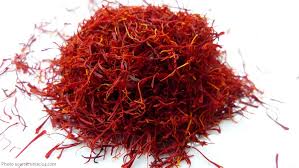Saffron/Crocus sativus L. (belongs to the plant family of Iridaceae)

Saffron, the most expensive spice in the world is derived from the dry stigmata of the plant Crocus Sativus. The plant is a bulbous, perennial with globular corms, 15-20 cm high. It has 6 to 10 leaves present at anthesis, one to two flowers with a lilac-purple colour with perianth segments of 3.5 – 5 cm and style branches of 2.5 – 3.2 cm. The yellow style is deeply divided into three branches and the stigmata are bright red. Flowers are arising directly from the corms. Flowers have tri-lobed stigma, which along with the style tops yield the saffron of commerce.
Saffron is used as a culinary seasoning and to colour, cottage cheese, chicken and meat, rise, mayonnaise, liquors and cordials. It is also used in speciality breads, cakes, confectionaries, Mughlai dishes. Saffron is also used as a perfume in cosmetics. In medicine saffron is used in fevers, melancholia, and enlargement of liver and spleen. In Ayurvedic medicine it is used to heal arthritis, impotence and infertility. It has wide range of uses in Chinese and Tibetan medicines.
FOREIGN NAME OF SPICES
Spanish : Azafran French : Safran German : Safran Swedish : Saffran Arabic : Zafran Dutch : Saffraan Italian : Zafferano Portuguese : Acofrao Russian : Shafran Japanese : Safuran Chinese : Fan Hung-Hua